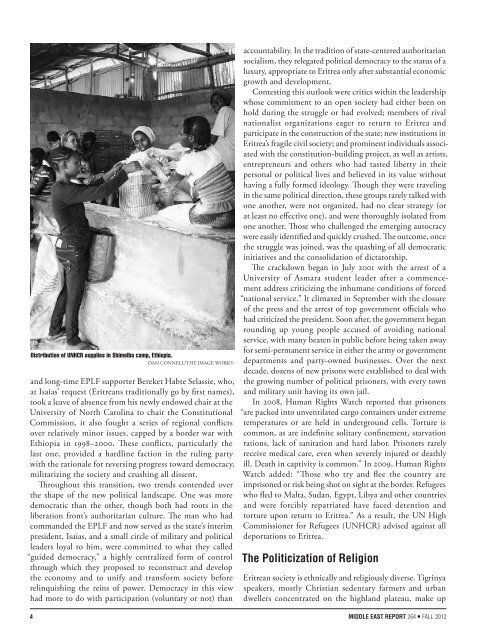Escaping Eritrea - Dan Connell
Escaping Eritrea - Dan Connell
Escaping Eritrea - Dan Connell
Create successful ePaper yourself
Turn your PDF publications into a flip-book with our unique Google optimized e-Paper software.
Distribution of UnHCR supplies in Shimelba camp, Ethiopia.<br />
DAn COnnEll/THE IMAgE WORkS<br />
and long-time EPlF supporter Bereket Habte Selassie, who,<br />
at Isaias’ request (<strong>Eritrea</strong>ns traditionally go by first names),<br />
took a leave of absence from his newly endowed chair at the<br />
University of north Carolina to chair the Constitutional<br />
Commission, it also fought a series of regional conflicts<br />
over relatively minor issues, capped by a border war with<br />
Ethiopia in 1998–2000. These conflicts, particularly the<br />
last one, provided a hardline faction in the ruling party<br />
with the rationale for reversing progress toward democracy,<br />
militarizing the society and crushing all dissent.<br />
Throughout this transition, two trends contended over<br />
the shape of the new political landscape. One was more<br />
democratic than the other, though both had roots in the<br />
liberation front’s authoritarian culture. The man who had<br />
commanded the EPlF and now served as the state’s interim<br />
president, Isaias, and a small circle of military and political<br />
leaders loyal to him, were committed to what they called<br />
“guided democracy,” a highly centralized form of control<br />
through which they proposed to reconstruct and develop<br />
the economy and to unify and transform society before<br />
relinquishing the reins of power. Democracy in this view<br />
had more to do with participation (voluntary or not) than<br />
accountability. In the tradition of state-centered authoritarian<br />
socialism, they relegated political democracy to the status of a<br />
luxury, appropriate to <strong>Eritrea</strong> only after substantial economic<br />
growth and development.<br />
Contesting this outlook were critics within the leadership<br />
whose commitment to an open society had either been on<br />
hold during the struggle or had evolved; members of rival<br />
nationalist organizations eager to return to <strong>Eritrea</strong> and<br />
participate in the construction of the state; new institutions in<br />
<strong>Eritrea</strong>’s fragile civil society; and prominent individuals associated<br />
with the constitution-building project, as well as artists,<br />
entrepreneurs and others who had tasted liberty in their<br />
personal or political lives and believed in its value without<br />
having a fully formed ideology. Though they were traveling<br />
in the same political direction, these groups rarely talked with<br />
one another, were not organized, had no clear strategy (or<br />
at least no effective one), and were thoroughly isolated from<br />
one another. Those who challenged the emerging autocracy<br />
were easily identified and quickly crushed. The outcome, once<br />
the struggle was joined, was the quashing of all democratic<br />
initiatives and the consolidation of dictatorship.<br />
The crackdown began in July 2001 with the arrest of a<br />
University of Asmara student leader after a commencement<br />
address criticizing the inhumane conditions of forced<br />
“national service.” It climaxed in September with the closure<br />
of the press and the arrest of top government officials who<br />
had criticized the president. Soon after, the government began<br />
rounding up young people accused of avoiding national<br />
service, with many beaten in public before being taken away<br />
for semi-permanent service in either the army or government<br />
departments and party-owned businesses. Over the next<br />
decade, dozens of new prisons were established to deal with<br />
the growing number of political prisoners, with every town<br />
and military unit having its own jail.<br />
In 2008, Human Rights Watch reported that prisoners<br />
“are packed into unventilated cargo containers under extreme<br />
temperatures or are held in underground cells. Torture is<br />
common, as are indefinite solitary confinement, starvation<br />
rations, lack of sanitation and hard labor. Prisoners rarely<br />
receive medical care, even when severely injured or deathly<br />
ill. Death in captivity is common.” In 2009, Human Rights<br />
Watch added: “Those who try and flee the country are<br />
imprisoned or risk being shot on sight at the border. Refugees<br />
who fled to Malta, Sudan, Egypt, libya and other countries<br />
and were forcibly repatriated have faced detention and<br />
torture upon return to <strong>Eritrea</strong>.” As a result, the Un High<br />
Commissioner for Refugees (UnHCR) advised against all<br />
deportations to <strong>Eritrea</strong>.<br />
the Politicization of Religion<br />
<strong>Eritrea</strong>n society is ethnically and religiously diverse. Tigrinya<br />
speakers, mostly Christian sedentary farmers and urban<br />
dwellers concentrated on the highland plateau, make up<br />
4 MIDDlE EAst REPoRt 264 ■ FALL 2012


